Sundews are one of my favorite plant groups. Sundews are carnivorous plants that gain nutrients by trapping insects with sticky secretions that form droplets on the stems and leaves. Tom Muroski on the State College carnivorous plant website states very simply how sundews trap their food.
The Sundew is covered with a series of short hairs, referred to as Tentacles, that each contain a ball of sticky liquid. When an insect touches this liquid, it tries to get out by squirming, but that only makes matters worse, since the little hairs start moving together in order to stick more of the liquid to the bug...Once the bug is caught, the hairs start to make acids and enzymes to break down the bugs. The remaining juice drips onto the leaf where it is absorbed into the plant for food.
Below is a photo I took in Worcester County, MD of a Spatula-leaved Sundew (Drosera intermedia) that has caught a Common Pondhawk.

Photo: Jim Brighton
All sundews belong to the genus Drosera. There are over 190 species worldwide. North America has ten species and the Mid Atlantic region has five species. The Drosera in our region are usually found in moist boggy areas with plenty of sunlight. Below, I am going to describe the five species of Drosera of our region and give enough information that the reader will be able to identify any sundew they stumble upon. First, I am going to give a brief glossary of some of the botanical terms that I will be using in the descriptions.
Cuneate -- wedge shaped
Glabrous -- smooth, a surface without hair
Glandular-pilose -- covered in fine soft hairs with secreting glandular ends
Obovate -- egg shaped and flat with the narrow end attached to the stalk
Petiole -- the stalk of the leaf that attaches to the stem
Pilose -- covered in fine soft hairs
Spatulate -- broad at the apex and tapered to the base
Round-leaved Sundew (Drosera rotundifolia)

Photo: Bill Bouton
In our region Drosera rotundifolia is found on and off the coastal plain. It is the only sundew that is found in the mountainous region of the Mid Atlantic.

The leaves are round, broader than long and shorter than the petioles. The petiole is very glandular-pilose.
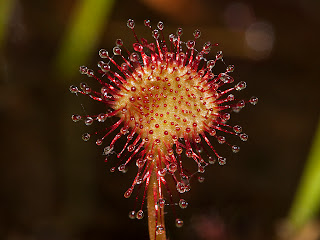
Photo: Bill Bouton
The flower of the Round-leaved Sundew is normally white but can be pink.
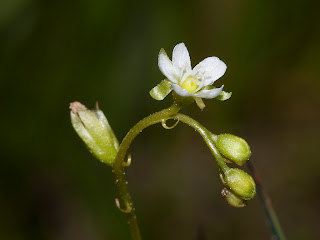
Photo: Bill Bouton
Pink Sundew (Drosera capillaris)
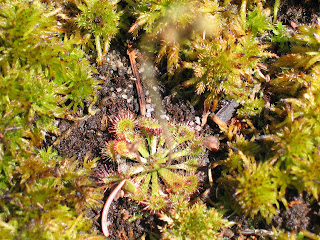
Photo: Wiki commons
The Pink Sundew is the common sundew of the southeastern coastal plain. It's northern most range is on the Delmarva Peninsula. Unfortunately, the Delaware population is extirpated and according to the Maryland Natural Heritage website there are only three populations left on the Eastern Shore of Maryland.
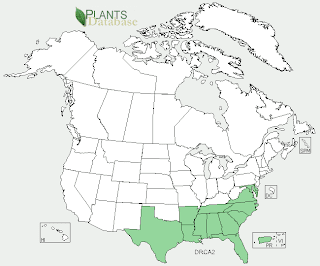
The petioles of the Pink Sundew are sparsely glandular-pilose and the leaves are broadly spatulate.

Photo: Barry Rice
The flower of the Pink Sundew is pink, but very rarely can be white.
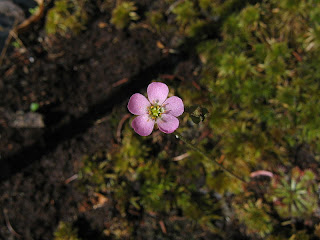
Photo: Wiki commons
Spatula-leaved Sundew (Drosera intermedia)

Photo: Chris Moody
Spatula-leaved Sundew is the common sundew on the Delmarva Peninsula and the coastal plain. Off the coastal plain it can be found in northeastern Pennsylvania, northern New Jersey, and throughout New York. Only a few populations exist in Virginia, all on the coastal plain. It's range in North Carolina is limited to the southeastern portion of the state.
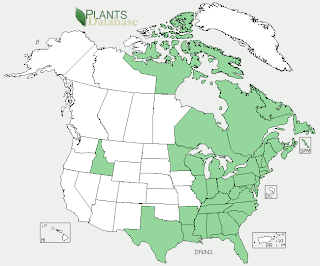
Drosera intermedia petioles are glabrous. This feature is diagnostic to the large sundews in our region. Its leaves are oblong spatulate or obovate.

Photo: Lisa Lawley
Dwarf Sundew (Drosera brevifolia)
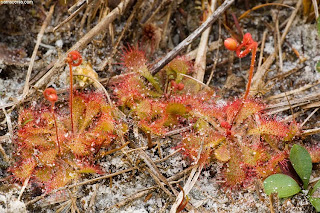
Photo: Barry Rice
Dwarf Sundews are found in the southern region of the Mid Atlantic. It is found on the coastal plain of Virginia and North Carolina. It can be easily overlooked because of its very small size and is generally not as common as the Pink Sundew. The two species can be found inhabiting the same areas.

Dwarf Sundews are easily identified by their small size. While the petioles are glabrous like Drosera intermedia, the petiole only measures 5-10mm compared to the 2-5cm of Drosera intermedia. The leaves are cuneate shaped and usually longer than the petioles.

Photo: Barry Rice
The flowers of the Dwarf Sundew range from pink to white.

Photo: Barry Rice
Thread-leaved Sundew (Drosera linearis)

Photo: Travel Stuffies
Thread-leaved Sundews have the smallest range of any of the sundews in our region. The largest populations are in the New Jersey Pine Barrens. Smaller populations are located on Long Island and the southeastern portion of North Carolina. Maryland has a population at Suitland Bog in Prince George's County, but this population is not native and the plants have not been observed in recent years. Drosera filiformis is extirpated from Delaware according to BONAP's North American Plant Atlas.

Thread-leaved Sundew looks nothing like any of our other sundews. The leaves of the plant are long and erect and the glandular hairs are purple colored.
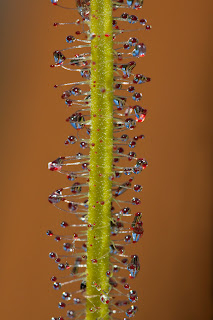
Photo: Natalie McNear
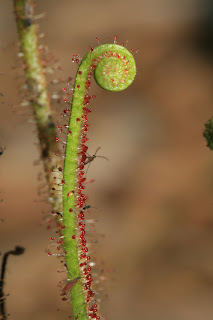
Photo: John Brandauer
The flower of Drosera filiformis is a purplish pink.
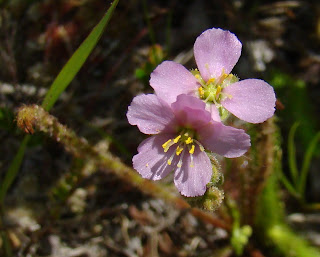
Photo: Anita Gould
The sundews and many other carnivorous plants are becoming scarcer as the wetlands where they live are drained for urban development and agricultural uses. While habitat destruction is the leading cause of these plants demise, collecting plants is also a serious problem. Many people do not realize that wild transplanted plants are very difficult to keep alive and most often die. For someone who would like to try to keep a carnivorous plant there are many breeders who raise captive bred plants which are much more likely to survive in a domesticated setting.
I would like to thank Barry Rice whose website www.sarracenia.com is the best site on web for carnivorous plants. He has more photos of species and varieties than any other website I have found. The information that is available on his site is amazing.
All of the other photos I used for this post were gleaned from the Flickr Creative Commons or Wiki commons. Below are links to the photographers photo sites.
Anita Gould -- http://www.flickr.com/photos/anitagould/
John Brandauer -- http://www.flickr.com/photos/91753832@N00/
Natalie McNear -- http://www.flickr.com/photos/midasvanderhand/
Travel Stuffies -- http://www.flickr.com/photos/oliviaandmike/
Lisa Lawley -- http://www.flickr.com/photos/34093448@N05/
Chris Moody -- http://www.flickr.com/photos/zpyder/
Bill Bouton -- http://www.flickr.com/photos/billbouton/
For the descriptions of each species I relied heavily on the website
http://www.omnisterra.com/botany/cp/pictures/drosera/0077.htm
On the website is a key to the North American Drosera.
Bonap's North American Plant Atlas has county level maps of all the North American Drosera
http://www.bonap.org/BONAPmaps2010/Drosera.html
USDA Plant Database, whose maps I used on this post, can be viewed at
http://plants.usda.gov/java/profile?symbol=DROSE
Here is a list of reputable carnivorous plant breeders
Botanique -- http://www.pitcherplant.com/
Carnivorous Plant Nursery -- http://www.carnivorousplantnursery.com/
California Carnivores -- http://www.californiacarnivores.com/
No comments:
Post a Comment